Comments from the Chair
Council delays action on Climate Action and Adaptation Plan
The public comment period on the City of San Antonio's (CoSA's) Climate Action and Adaptation Plan (CAAP) was extended until March 26 — and now until April 25. City Council's vote was delayed until May 16 — and now until “fall”. The vote on CAAP therefore will occur after municipal elections, during “lame duck” sessions prior to investiture of the new Council — no... now delayed until Fall 2019.
The CAAP is getting significant public attention finally, and substantial business opposition. CAAP will be a major campaign issue. It is vital for our future that CoSA adopt the CAAP!
Business opposition is centered on “cost” and reflects traditional business opposition to change that may disrupt profit models. Despite lip service to “free enterprise” these groups always seem to support protectionism for their status quo, often monopoly status.
CAAP does not, in fact, provide nearly as much cost (and cost benefit) information as it should, or as was originally planned. This is one of many deficiencies that occurred in this imperfect process, with the consultant group Navigant using up all the money allotted before finishing this vital part of the work. However, more than 100 other U.S. cities--including large cities like Atlanta--are committed to similar and more ambitious goals than our CAAP. Costs are not insurmountable, as the cost of doing nothing is far greater.
The bad news is that all the latest studies suggest action must be taken by 2030 to avert the worst consequences of climate change and bend the curve of carbon emissions back. The good news is that our scientific understanding is better than ever, and that we now have the latest technology to achieve needed changes.
The global climate crisis is neither fake nor hopeless. We have the means to not only avert disaster, but greatly improve our quality of life. The question is do we have the political will to do so? Pointing fingers at China is not the answer. All large economies are making climate change adjustments right now, including China. Much of the U.S. is doing so, despite resistance at our federal level, and among some states like Texas. We can choose to support the Koch brothers, or our community.
City leaders unwilling to stand up for CAAP
Note: the above section was modified on the afternoon of 3/27/19. It is now clear that our “leaders” — most notably our Mayor — proved unwilling to stand up for the climate plan they created. The San Antonio power structure remains intact, clearly. This decision will take the energy out of volunteers (see below) and will take the CAAP out of public discussion. Six to 8 months from now CoSA will pass another weak document that will gather dust.
Our climate efforts are failing due to our failing leaders. It is appropriate that this decision is announced on the same day as a damning opinion piece about Mayor Nirenberg’s embrace of triangulation over principle (Please see: Mayor shies from morals of Chick-fil-A vote). Join the 3rd annual SA March for Science to protest business as usual!!
Political Committee working hard to elect good Council candidates
Our Political Committee has been busy. Environmental issue questionnaires were sent to all candidates for ten City Council districts, and Mayor. Interviews are being conducted with many candidates. Endorsement decisions hopefully will be complete by early April.
We need volunteers to work for our candidates. We made a major impact in municipal elections two years ago, and need to do so again.
CPS Energy and SAWS — the continuing saga
CAAP carbon emission goals will not be met unless we can convince CPS to close its Spruce 1 and 2 coal plants by 2030. We need to keep pushing for more renewable energy and energy efficiency progress. CPS has proved very resistant to this.
League of Independent Voters is calling for an investigation of the Vista Ridge water pipeline. We continue to seek answers about this project and share many of the League's concerns. We hope that the next City Council will provide us with more answers, and will support our calls for much more transparency at both utilities.
We are also dismayed that SAWS is ignoring its own bylaws in not replacing Board Chair Berto Guerra when term limits require. The fact that he wishes to stay to see Vista Ridge water flow does not make him entitled to subvert the bylaws by a year. SAWS has not even begun to look for a new member. Read more in my recent opinion piece published in the Express-News: Public input needed on SAWS, CPS.
Time for healthy transportation
Mobility in SA is a key problem for our quality of life, and a major contributor to our unhealthy air quality, and our carbon emissions. CAAP goals require major and rapid changes to how we move around SA.
Public health goals demand we increase physical activity through walking, bicycling and other forms of exercise. Public safety demands we improve the negative health and cost impacts of our hazardous mobility, working to achieve Vision Zero goals for pedestrian and bicycle travel, and reduced vehicle morbidity and mortality.
Our near complete dependence on private (largely single passenger) vehicle travel for even very short trips has trapped us in a maze of our own doing. We cannot safely walk across the street to pick up something at the local store. We cannot bicycle to work. In neighborhoods without continuous sidewalks we can barely walk at all.
Our VIA system is desperately underfunded and inadequate for our needs, and so its low ridership becomes a self fulfilling negative feedback loop.
Watch out, the Lege is in session!
The 86th Texas Legislature — another venue for failed leadership on our environment. We can be very appreciative of our Senator José Menéndez for his introduction of several (at least 10) good environmental bills.
April 11th is Sierra Club Lobby Day in Austin. Be sure to register in advance and join us for a productive and exciting trip. There are good bills and many other bad bills that need our efforts. Keep up to date on legislation at the Lone Star Chapter's Texas Legislature page.
Finally...
April 22nd is Earth Day. Do something to help our home!!
by Terry Burns, M.D., Alamo Group Chair
Bears Ears National Monument — What is There? What's At Risk?
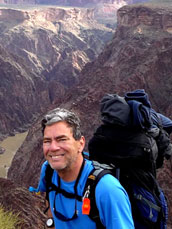
Bears Ears was designated a national monument by President Obama in 2016 and undesignated by President Trump in 2017; the latter event is the subject of ongoing litigation. Trump's reversal was done largely in favor of oil/gas and minerals extraction interests.
Kevin Hartley, Alamo Group Outings Leader, will show slides of this spectacular area and discuss Trump's reversal of Bears Ears' national monument designation.
Thursday, April 25th
6:30 p.m.
Lions Field Adult Center, 2809 Broadway @ Mulberry
Map
Bears Ears is a vast area in southeastern Utah; literally everywhere there are identified sites of prehistoric peoples within spectacular sandstone canyons. Included are places such as Cedar Mesa, Valley of the Gods, Comb Ridge, Dark Canyon, and Lockhart Basin. Come hear about the interested parties and see some pictures of the canyons, mesas and ruins, many easily accessible via car camping and day hikes.
This meeting is free and open to the public.
Bears Ears National Monument — A Treasure Under Attack
Before President Trump was elected, a national monument designation had never been reversed. Authority to designate monuments resides with the president per the 1906 Antiquities Act. Bears Ears was designated a national monument in 2016, by President Obama, after an extensive period of public input and major support from local Native American tribes.
Trump reversed the monument designation in December 2017, largely to benefit oil/gas and mining interests. This reversal gave rise to lawsuits by many tribes and environmental organizations.
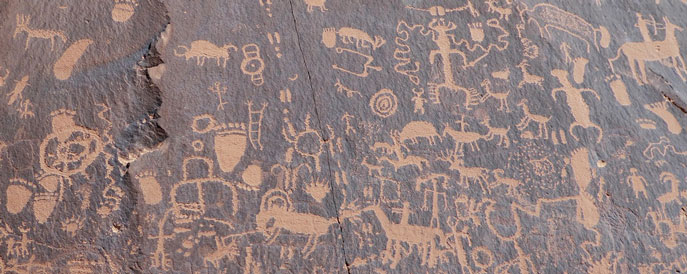
See the March 2017 issue for an earlier article on Bears Ears and a few pictures. And in the January 2018 issue there was an article, with a Bears Ears update, on Natural Bridges National Monument, which is a smaller monument at the center of Bears Ears.
As mentioned in the March 2017 issue, Bears Ears is a very large diverse area; the contrasts between the different areas (that's a link to an interactive map with lots of pictures) are enormous. Along with the pictures in the above articles are the ones below are of just two key areas: Comb Ridge and Cedar Mesa. Here is a picture at PBS.org of the Bears Ears buttes looking north from Cedar Mesa, along with a story about a big list of other national monuments under threat.
The designation reversal results in greatly increased threats to the environment posed by minerals exploitation, and to the archaeological record of the earliest peoples in the area, the Ancestral Puebloans (formerly termed Anasazi). There are 100,000+ archaeological sites within the monument, which means that people lived virtually everywhere in the area during the period ~6000 BCE-1300 CE. For example here is another good website on the monument with a map of Cedar Mesa and Comb Ridge showing the locations of hundreds of major ruins that can most easily be visited. Look but don't touch!
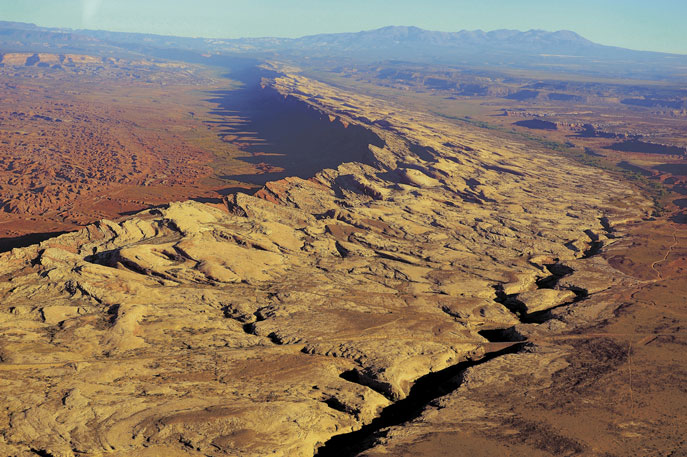
The Comb Ridge monocline, aerial photo, looking north. Far more dramatic than my pictures from the ground! The yellow rock is Navajo sandstone, one of the most widespread sandstone formations anywhere. Cedar Mesa is just out of the picture to the left, and US 163 runs across the bottom. Comb Wash Road is just left of the ridge and Butler Wash Road is on the right, making a super 48-mile loop drive around 2/3 of the entire monocline between US 163 and Utah Hwy 95. High clearance advised and some sections may be impassable when wet. Many ruins are easily accessible in the canyons within the ridge; for example, in the last picture below. The Abajo Mountains are visible upper right. Photo credit: San Juan Record, Karen Shumway.
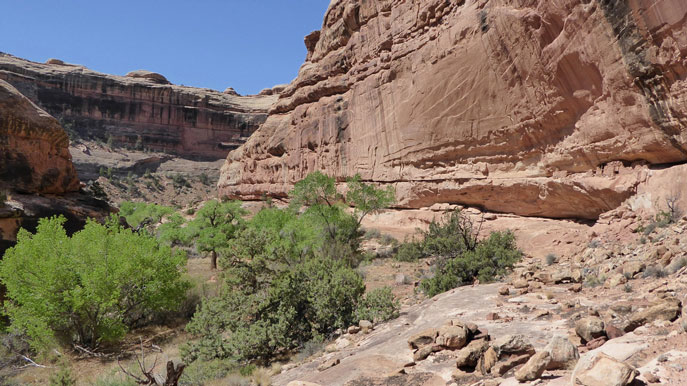
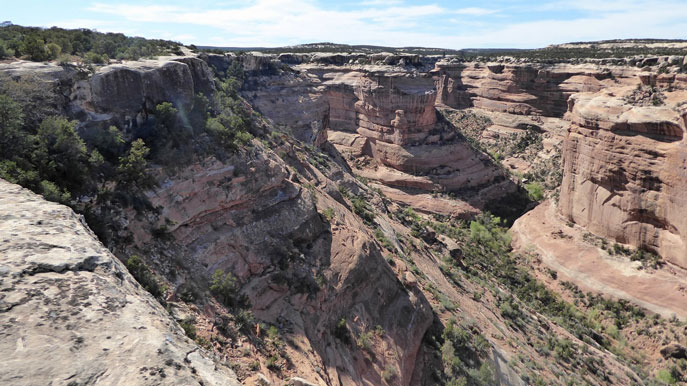
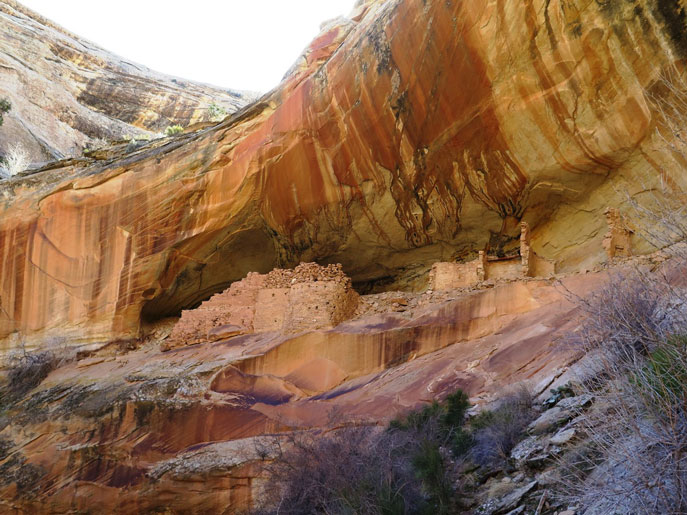
Making Converts, One Bag at a Time
Have extra re-usable shopping bags? I routinely get new free re-usable shopping bags at environmental events and meetings. I have so many that I sometimes refuse them (Refuse, Reduce, Reuse, Recycle).
However, if you currently have more than you can use, take an extra one to the grocery store next time you shop. Use them for your groceries and then, when you are in the cash register line, turn to the person in front or behind and offer them the extra shopping bag.
Try to offer bags that are new, or close to new, so the other shopper doesn’t have a knee-jerk rejection based on pre-ownership of the bag. It’s a great way to put the bags to good use and start a conversation about reducing and getting rid of plastic shopping bags. Talk about keeping them in the car for convenience and spontaneous shopping.
If you care to do more, engage the checkout clerks in conversations about eliminating plastic bags in their store. Take a moment to talk to the store manager about reducing or eliminating plastic bags. Never underestimate the power of polite, persistent persuasion!
by Alan Montemayor, Executive Committee member
April General Meeting
The subject of our April general meeting will be announced on our web calendar.
Tuesday, April 16th
6:30 p.m. {refreshments served beginning at 6}
William R. Sinkin Eco Centro, 1802 North Main Avenue
Map
This event is free and open to the public.
Bulverde Developments Would Discharge Treated Sewage Into Aquifer
The past decade has seen numerous developments sprouting up in the area around Bulverde, Texas. Driven by close proximity to the one of the fastest-growing cities in the U.S., the sprawling development in the Bulverde area is going largely unchecked, causing all sorts of problems for local residents.
Winding through the Bulverde area is Cibolo Creek, a tributary of the San Antonio River. Cibolo Creek is unique in that it contains numerous faults and fractures that recharge the Edwards Aquifer. This connection between Cibolo Creek and the Edwards provides groundwater for many who rely on wells for their household use and contributes to a healthy Edwards ecosystem. Since developers are proposing very high density projects with as many as five or six houses per acre, multiple sewage treatment plants seeking to discharge treated sewage effluent into local creeks and streams have popped up to handle the waste of the burgeoning Bulverde population.
While treated sewage has undergone removal of solids and bacteria, it is still high in nutrients such as nitrogen and phosphorous, which are harmful to humans if ingested in high quantities. Treated sewage, or effluent, also contains pharmaceuticals, hormones, microplastics, and other harmful chemicals which can’t be easily removed during the sewage treatment process.
By Texas law, it is illegal to discharge treated sewage directly into waterways over the Edwards Aquifer Recharge Zone. But developers have exploited a loophole in the law, discharging instead into dry ditches and small tributaries that flow into Cibolo Creek and hence, into the Edwards Aquifer. In essence, directly discharging sewage effluent into these small streams and creeks which flow through the properties of others and may have a negative impact on the water they draw from their wells is akin to you dumping your trash in your neighbor’s yard.
Fig. 1 below shows all of the development tracts in the Bulverde area, including the status of existing TPDES (treated sewage discharge) permits. The TCEQ has already approved numerous permits to dump treated sewage into both Cibolo Creek (to the south and east of Bulverde) and the Guadalupe River (to the north), with several other permits recently submitted for approval. The TCEQ has approved almost every TPDES permit that has been submitted by developers and municipalities in recent years. The only line of defense for concerned area residents has been environmental organizations like the Greater Edwards Aquifer Alliance (GEAA), who organize local residents and help raise funds for legal challenges to the permits. While the treated sewage discharges are happening all over the Texas Hill Country, the heavy concentration of so many wastewater plants so close to the Edwards Aquifer recharge zone in Bulverde is of great concern.

One area of particular concern includes the Edgebrook, Copper Canyon, and Johnson Ranch developments, all located in the same area east of Highway 281 near Bulverde (see Fig. 2 below). All three developments have TCEQ permits to discharge into Cibolo Creek via two wastewater treatment plants, the South Central Water Company (SCWC) plant and the Johnson Ranch plant. Both plants have just recently begun discharging into Cibolo Creek via ditches that are less than ¾ mile away from Cibolo Creek/the Edwards Aquifer recharge zone.

Despite the fact that the two wastewater plants are discharging relatively small amounts of effluent, the local effects have already been dramatic, as Fig. 3 and Fig. 4 below clearly show. It doesn’t take much treated sewage to turn a pristine creek into an algae-filled slime pool.

The SWSC plant is likely discharging less than 50,000 gallons per day of effluent, but their current permit allows for up to 10 times that amount, 500,000 gallons per day. They have just applied for a permit upgrade to 950,000 gallons per day, which they will likely receive from the TCEQ. The Johnson Ranch plant is also discharging just a fraction of their 350,000 gallons per day allowable permit, but this amount will increase substantially, as the 1000-home Johnson Ranch development gets built out.

An accidental spill or discharge of raw sewage or partially-treated sewage from either the SCWC or Johnson Ranch plants would be catastrophic, given that water entering the Edwards is not filtered and travels rapidly within the Edwards Aquifer. But even under normal operation, following standard procedures and safeguards for wastewater treatment plants, the local impacts could be severe for nearby residents who depend on the Edwards Aquifer for their drinking water.
The Greater Edwards Aquifer Alliance needs your support to fight the proliferation of treated sewage dumping in the Texas Hill Country. Please visit our website for more information and to see how you can advocate for preserving one of the world’s most prolific aquifers and for keeping Hill Country streams and rivers clean.
by Mike Clifford and Annalisa Peace, Greater Edwards Aquifer Alliance
Cast Your Vote in the 2019 Sierra Club Board of Directors Election Today!
I hope you will take this opportunity to exercise one of the most important responsibilities of your membership and vote for the Sierra Club Board of Directors. It will take only a few moments of your time, but the impact to our organization, our mission and our planet will be far reaching.
The Board of Directors is the governing body of the Sierra Club. The Board has the responsibility and authority to oversee all staff and volunteer activities of the Sierra Club, to establish the Sierra Club's conservation priorities and internal policies, and to adopt and implement our annual budget. The Board of Directors elects the Sierra Club's officers, including the President and the rest of the Executive Committee, and selects the Sierra Club's Executive Director. Their strong leadership and dedication are critical to the ongoing effectiveness of the Sierra Club.
For members who receive household ballots, two Sequence B numbers have been assigned, one for each eligible voter. Once you have logged in, you must complete the voting process by submitting your vote and wait for the login screen to re-appear before the other joint member can vote.
Voting is quick and easy:
- Go to: https://www.esc-vote.com/sierra2019
- You will need the following numbers to log in:
Your Sequence A Number:
Your Sequence B Numbers: - Cast your vote for up to five Board of Directors candidates.
For more candidate information, go to http://www.sierraclub.org/board/election. If you have any questions about voting online, please contact Election Services Co. by email at sierraclub@electionservicescorp.com or call toll-free 1-866-720-HELP (4357), 9:00 am - 5:00 pm, Eastern Time.
Your votes must be received by noon EDT, Wednesday, April 24th.
More Public Input Needed in Public Utility Decisions
Note: this commentary was published in the March 25, 2019 issue of the San Antonio Express-News
San Antonio is lucky to be one of a few large American cities where electricity and water are provided by publicly owned utilities. We are not at the mercy of private corporations maximizing profit at our expense and changing ownership by hedge fund speculators.
But how different are SAWS and CPS Energy? Each has a board of trustees, with members approved by City Council. Our mayor serves as an ex-officio member of each board. Each must submit customer rate proposals to City Council for approval.
Unfortunately, city oversight is more apparent than real. Both utilities have a long history of functioning as private corporations seeking maximum revenue, service growth and promotion of city business growth, with City Council rubber stamping rate increases, board nominees and wasteful misguided projects like Vista Ridge and Spruce 2. These are both billion-dollar projects that should never have been built, were built over heated public opposition and will become “stranded assets,” costing us all.
Our city government accepts one-third of its budget from utility sources as recompense for its hands-off approach to our “publicly owned” utilities.
In the past, we put the “public” back in our “public utilities.” Public policy direction of our utilities should be set by the City Council; our utilities should act in accord with those policies. Our utilities should not have their own legislative agendas and their own paid lobbyists in Austin. These efforts should be integrated into city efforts.
Major public policy decisions should be initiated and vetted by our city, not the utility. Resource planning by the city of San Antonio, with full public involvement throughout, would have avoided the Vista Ridge and Spruce 2 debacles.
Utility board meetings should follow open government rules, and CPS Citizens Advisory Committee should not function in secret. Board appointments should be done by a public process, with published criteria and questionnaires for selection. Interviews with applicants should be public with the same participation guidelines the city recently adopted for itself. CEO selection for CPS and SAWS should be handled in a similar public process and city manager likewise.
Our CEOs, Paula Gold-Williams of CPS and Robert R. Puente of SAWS, like our city manager, should have public accountability. How, for example, is it possible to have no conflict of interest with Gold-Williams serving as chair of the San Antonio Chamber of Commerce?
For the second time in a year, CPS has selected — in secret — a new board member, who will have some token public outreach opportunities, and like City Manager Erik Walsh, go to council for an up or down vote. SAWS board Chairman Berto Guerra is nearing the end of his second four-year term, to which he is legally limited. Nonetheless, there is no action by SAWS to begin replacement proceedings — Guerra having indicated his desire to continue on until Vista Ridge water begins flowing in 2020.
Our democracy is crippled by a good old boy network that holds us in a “growth is good, sprawl is great” model. We need more than diversity of gender and ethnic origin on our boards and council. Diversity of thought would make the CPS Energy and SAWS boards stronger, but this process of self-selecting replacements without public input all but guarantees that won’t happen.
At their first Council A Session, council and Mayor Ron Nirenberg passed a resolution committing us to meet the Paris climate agreement goals. Now, the city has released a Climate Action and Adaptation Plan without any commitment from CPS to end its use of fossil fuels. This plan needs to be backed up with real action. CPS fails to commit, sticking to its false “flexible” stance. I urge voters to judge our council and mayor by their actions to rein in our utilities now.
Terry Burns, M.D., is chair of the Alamo Group of the Sierra Club

Outings: The Call of the Wild
Visit the Alamo Sierra Club Outings page on Meetup for detailed information about all of our upcoming Sierra Club Outings.
The Alamo Sierran Newsletter
Richard Alles, Editor
Published by The Alamo Group of the Sierra Club, P.O. Box 6443, San Antonio, TX 78209, AlamoSierraClub.org.
The Alamo Group is one of 13 regional groups within the Lone Star Chapter of the Sierra Club.
Changed your mailing address?
Have you moved? Let us know by sending your old address, your new address and your member number (look on the upper left corner of your mailing label) to: address.changes@sierraclub.org.
Go online for the latest news and events
 |